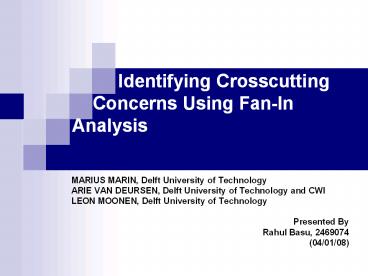Identifying Crosscutting Concerns Using Fan-In Analysis - PowerPoint PPT Presentation
1 / 11
Title:
Identifying Crosscutting Concerns Using Fan-In Analysis
Description:
Identifying Crosscutting Concerns Using Fan-In Analysis MARIUS MARIN, Delft University of Technology ARIE VAN DEURSEN, Delft ... non-aspect oriented code. – PowerPoint PPT presentation
Number of Views:95
Avg rating:3.0/5.0
Title: Identifying Crosscutting Concerns Using Fan-In Analysis
1
Identifying Crosscutting
Concerns Using Fan-In Analysis
- MARIUS MARIN, Delft University of Technology
- ARIE VAN DEURSEN, Delft University of Technology
and CWI - LEON MOONEN, Delft University of Technology
- Presented By
- Rahul Basu, 2469074
- (04/01/08)
2
Introduction
- What is crosscutting concern?
- Cross-cutting concerns are aspects of a program
which affect other concerns. These concerns often
cannot be cleanly decomposed from the rest of the
system in both the design and implementation, and
result in either scattering or tangling of the
program, or both.
3
- Aspect mining is an upcoming research direction
aimed at finding crosscutting concerns in
existing, non-aspect oriented code. Once these
concerns have been identified, they can be used
for program understanding purposes. - Fan-in analysis, an aspect mining approach that
involves looking for methods that are called from
many different call sites and whose functionality
is needed across different methods, potentially
spread over many classes and packages. - Fan-in analysis is a semi automated process
consisting of three steps. First, we identify the
methods with the highest fan-in values. Second,
we filter out methods that may have a high fan-in
but for which it is unlikely that there is a
systematic pattern in their usage that could be
exploited in an aspect solution. Third, we
inspect the call sites of the high fan-in
methods, in order to determine if the method in
question does indeed implement crosscutting
functionality.
4
(No Transcript)
5
ASPECT MINING USING FAN-IN ANALYSIS
- Fan-in analysis consists of three steps
- Computation of the fan-in metric for all methods
- Filtering of the set of methods to obtain the
methods that are most likely to implement
crosscutting behavior - Analysis of the remaining methods to determine
which of them are part of the implementation of a
crosscutting concern
A Fan-In Metric for Aspect Mining
- The metric we will use for aspect mining is based
on method fan-in, which is a measure of the
number of methods that call some other method - First refinement is to count the number of
different method bodies that call some other
method - Second refinement deals with calls to polymorphic
methods
6
(No Transcript)
7
Method Filtering
- After computing the fan-in values of all methods,
the filters are - applied, in order to obtain a smaller set of
methods with a higher - chance of implementing crosscutting behavior.
- - restrict the set of methods to those having a
fan-in above a certain threshold. - - filtering getters and setters from the list of
methods. - - filtering the utility methods.
Seed Analysis
Final step is to conduct a manual analysis of the
remaining set of methods. This analysis follows a
number of guidelines, part of which benefit from
automatic support. Reasoning about the reported
candidates can take a top-down or bottom-up
approach.
8
The Fan-in Tool FINT
- The Fan-in Tool FINT is an Eclipse plug-in that
provides automatic support for the metric
computation, method filtering, and candidate
analysis steps of fan-in analysis.
9
- Analyzing the callers of a method with a high
fan-in value by investigating their declaring
interfaces. The callers declared by the same
interface are shown in a same, distinctive color.
Such analysis is helpful, for example, in
identification of crosscutting responsibilities
that are to be fulfilled by a number of classes.
10
Case Studies
- We have applied fan-in analysis to several case
studies. - All cases are open source systems, allowing
validation of our results by others. The PETSTORE
and JHOTDRAW systems are demonstration
applications of J2EE technologies and design
patterns. respectively. TOMCAT is the largest
system, and one that is widely used in Web
servers all over the world.
11
Conclusion Future Work
- Contributions
- A new, metrics-based, aspect mining approach that
aims at capturing crosscutting concerns by
focusing on methods that are called from many
places, and hence have a high fan-in. - FINT, a freely downloadable tool that supports
fan-in analysis. - Future Work
- Considering various extensions to FINT. One route
is to integrate FINT with other concern
elaboration tools, such as FEAT or the Concern
Manipulation Environment CME. - Combine FINT with other automated aspect
identification techniques, such as, for example,
techniques based on formal concept analysis,
identifier analysis, or clone detection.































